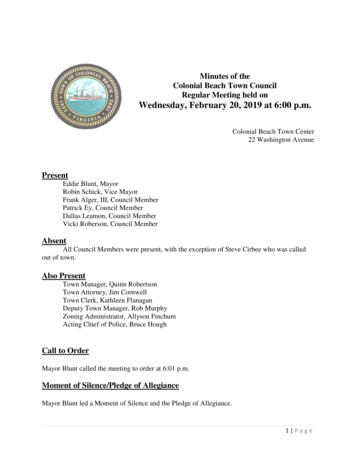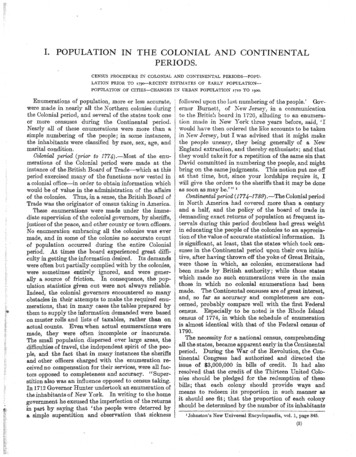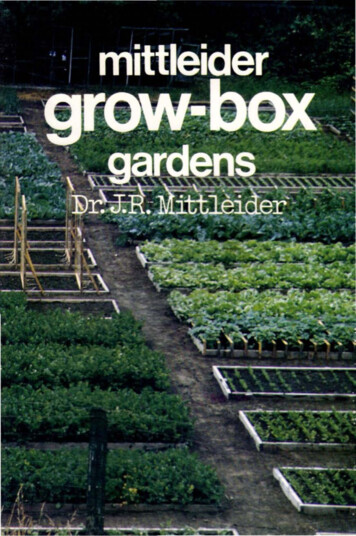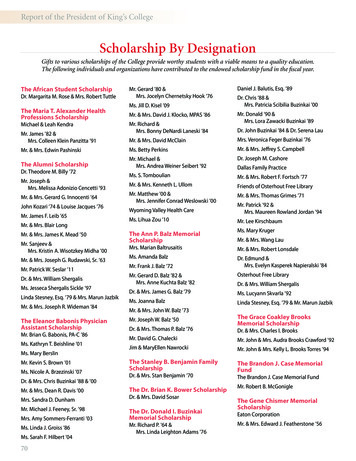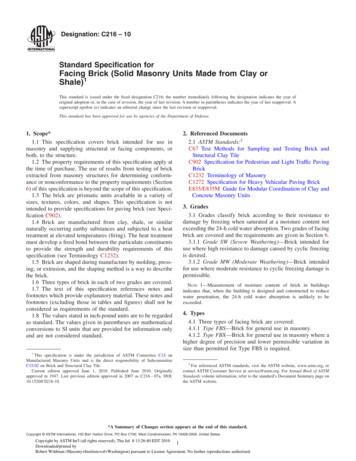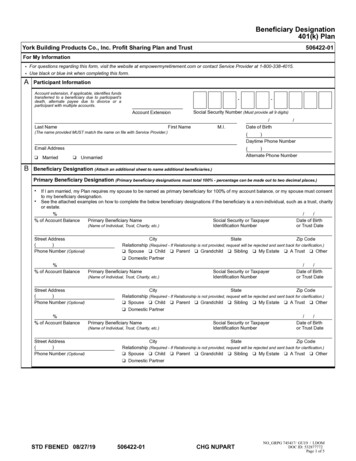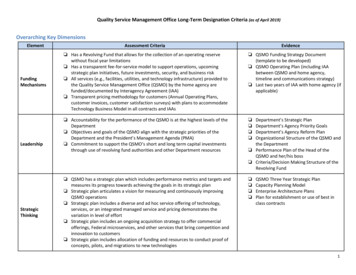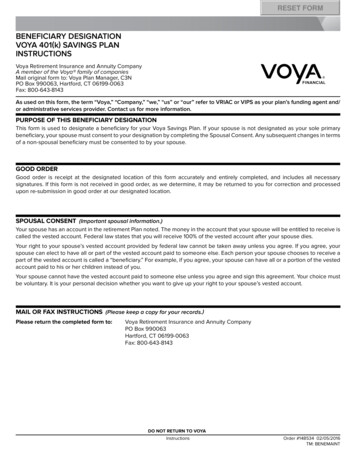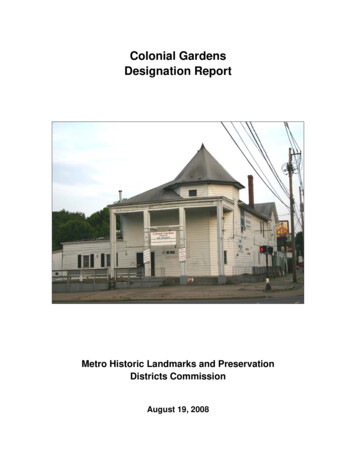
Transcription
Colonial GardensDesignation ReportMetro Historic Landmarks and PreservationDistricts CommissionAugust 19, 2008
Colonial Gardens Local Landmark Designation ReportMetro Historic Landmarks and Preservation Districts CommissionLocationThe property for consideration is located at 818 West Kenwood Drive on the southeastcorner of the intersection of Kenwood Drive and New Cut Road. Colonial Gardens issituated on the east side of New Cut Road opposite Iroquois Park approximately 150yards northeast of the Iroquois Amphitheater.DescriptionColonial Gardens is sited close to the corner of Kenwood Drive and New Cut Roadwhich relates to its historic use as a roadside attraction. The building’s façade isoriented to the north. Currently, parking lots are located to the east and south of thebuilding. Situated at the south end of the property parallel to the property line is aconcrete block structure that formerly housed a dry cleaning business that is considerednon-contributing. A pizza restaurant is located on the adjacent property to the east ofthe structure.Colonial Gardens is a two-and-a-half story, gable-roofed, frame Colonial Revival Stylestructure. Originally clad with wood siding, aluminum siding was later added to thebuilding. The original building which fronts Kenwood Drive was constructed in 1902.The building’s most striking features and those that articulate its early twentieth centuryColonial Revival Style include the two-story wooden portico composed of a low, flat roofsupported by four square piers, a primary entrance surmounted by a fanlight andflanked by sidelights, multi-pane window sash, and the corner tower, which takesadvantage of the corner location and provides an eclectic note reflective of its roadsidecontext. The portico and one-story projecting elements to the east were originallytopped by a classical balustrade that has been removed.Other alterations to the original building have occurred over its history. All but two northfacing windows, including the fanlight and sidelights have been covered by aluminumsiding and numerous windows on the west façade have been covered with aluminum orplywood. Though the original sash may no longer be intact, physical and documentaryevidence should allow window restoration. An original chimney and two, single-storyporches have been removed. A concrete block addition at the southern end of thebuilding houses a liquor store. Despite these changes the original building’s form andcharacter defining features are intact.HistoryColonial Gardens played a critical role in the development of the South End andIroquois Park. It was built by innovative entrepreneurs’ Fred and Minnie Senning in1902. Carl Frederick Senning, from Kesse, Germany arrived in Louisville in 1868 andmarried Minnie Goeper in 1877. They purchased their first restaurant in downtownColonial Gardens Local Landmark Designation ReportMetro Historic Landmarks and Preservation Districts Commission2
Louisville at 407 West Market Street. Five years later they opened a restaurant andhotel on east 8th Street. The Sennings were known for introducing new experiences toLouisville and it is said that they introduced finger bowls in the dining room and the firstbowling alley.As the streetcar reached out to South Louisville and the Grand Boulevard stretched toIroquois Park, the Sennings too found themselves heading south, finally settling atKenwood Drive and New Cut Road, across the street from Iroquois Park. Here theybuilt Senning’s Park and the Senning family continued to introduce Louisville to newattractions for the next four decades. The top floor of the main building served as livingquarters for the Senning family. In 1920, their son, William Senning took over the familybusiness. He continued to operate the restaurant and beer garden and eventuallyopened Louisville’s first zoo on the premises. The popularity of the zoo helped bolsterattendance for both Iroquois Park and Senning’s Park.The histories of Iroquois Park and the Colonial Garden’s structure have beenintertwined since the inception of both. Senning’s Park was a known hot spot forpolitical dinners and documented history indicates that six Governors were nominatedfrom the gazebo that once graced the beer garden. In its heyday, the popularity ofSenning’s Park prompted the Louisville Street Railway Company to add cars to theirservice to Third and New Cut Road. For the observance of Decoration Day, the parkreportedly prepared for a crowd of between eight to ten thousand people.Patrons came via the trolley, had dinner at Sennings and spent the day at the park. TheSennings and Colonial Gardens struggled through the Depression but operationscontinued until Fred Senning’s death on December 6, 1939. Senning’s Park was sold toB. A. Watson for 15,000. He remodeled the property and named it the Colonial Barand Grill. During the 1940s, Colonial Gardens hosted big band entertainment anddancing. Patrons came for dinner and made their way across the street for a show atthe amphitheater.In the 1950s, Colonial Gardens was purchased by Herm Schmid. Eventually, it becameknown as the Teen Bar, a strictly non-alcoholic venue popular with South End teenscomplete with its own newsletter. Teen Bar became known as the place to watch orparticipate in all of the popular dances. The popular Jitterbug contest, held onWednesday evenings, was hosted by Ed Kallay. Around 1956, Colonial Gardens wasacquired by Carl Coons, who changed the name to Carl’s Bar. In 1959, Wilburn “Curly”Bryant leased the property and changed the name back to Colonial Gardens. Bryantoperated Colonial Gardens until his death in 1983 and management was assumed byhis son John. During the Bryant years, Colonial Gardens was known for its liveentertainment. During the 1950s and 1960s, popular bands featured included theSultans and Monarchs. The 1970s saw the introduction of the country and UrbanCowboy themes. Activities upstairs included pool, darts, karaoke, and a small bar,while the downstairs included the main dance floor, bands, and main bar.Colonial Gardens Local Landmark Designation ReportMetro Historic Landmarks and Preservation Districts Commission3
Despite Colonial Gardens strong association with Iroquois Park and people in the SouthEnd and the entire city of Louisville, business began to wane and its doors were closedin June of 2003. A capacity crowd of over 600 attended the farewell.SignificanceColonial Gardens represents the last of the historic road house, beer garden, andentertainment venues that once defined Louisville’s South End. In addition to ColonialGardens, the area once boasted numerous beer gardens, including Simm’s Corner,Summer’s Park, Iroquois Gardens, the Calico Club, and Gordon’s Corner. All of thesevenues have been lost to new development. Colonial Gardens has been a landmark inthe community for over 100 years and highlights one of the entrances to one ofFrederick Law Olmsted’s most prominent parks, Iroquois Park.The area that included Kenwood Hill or “Sunshine Hill” as it was known in earlier timesand later as Cox’s Knob was purchased by Benoni Figg in 1864. Land was cleared forhis charcoal business and later he built a small sawmill, opened a rock quarry, andconstructed the L&N Railroad Company’s Strawberry Station at the intersection of NewCut and Third Street Roads. In 1876, Figg’s daughter, Mary, and her new husband,Charles W. Gheens, acquired half of the heavily wooded property and fourteen yearslater sold it to Sam Stone Bush and the Kenwood Park Residential Company.In 1888, Louisville Mayor, Charles Jacob, bought 300 acres of the Burnt Knob for thecity’s largest park, known first as Jacob’s Park and later Iroquois Park. By the secondhalf of the nineteenth century, New Cut Road extended south from the Louisville andNashville Turnpike between the Burnt Knob and Cox’s Knob before continuingsouthward to the county line. The Fourth Street streetcar line was extended pastChurchill Downs out Third Street to the entrance of the new city park. By the turn of thecentury, Senning’s Park was an established entertainment center at the corner ofKenwood Avenue and New Cut Road. Although the opening in 1893 of the GrandBoulevard, modern-day Southern Parkway, allowed easier transportation to the area,the first suburban residents were wealthy families who built retreats in the area toescape the summer heat.Residential development remained sparse until subdivision activity began in the 1930sand 1940s. The Iroquois Amphitheater was built by the Works Progress Administrationand in 1939, Lou Tate bought property on Kenwood Hill that included three Bush familysummer homes and a shed left by Benoni Figg. This property would become agathering place for textile artists from around the world and became known as the LittleLoomhouse.As citizens moved farther from the city’s core after World War II, this primarilyresidential area became a popular site for development, especially during the 1950s.Residential development accelerated in the 1960s when Kenwood Hill was extensivelydeveloped by T.G. Eckles and his son, William Eckles and when Robert ThienemanColonial Gardens Local Landmark Designation ReportMetro Historic Landmarks and Preservation Districts Commission4
developed Kenwood Terrace on the southern slopes of Iroquois Hill. By the end of the1960s, the residential character of the Iroquois area was well established.As area roads, like New Cut Road, were improved with modern paving to become twolane highways, a need for roadside services emerged to aid motorists. Mom-and-popestablishments were the first types of businesses to locate along the roadside. In an erabefore corporate chains became the dominant commercial type, locally-owned motels,restaurants, gas stations, and general stores dotted the roadways. Typically, theproprietors lived on the premises to be able to serve customers at any hour.Roadside restaurants and entertainment venues emerged as a twentieth centuryphenomenon to serve motorists and residents in the outlying areas of the city. Eatingoutside of the home was not an entirely new concept, since dining establishments couldbe found in hotels and along Main Street. Prior to the development of modern pavedroadways and automobiles, taverns served travelers on horseback or stagecoaches.The roadside restaurant distinguished itself from other eateries by being quick,convenient, and accessible. As transportation routes to major cities improved withintroduction of the car, roadside services emerged to accommodate both local residentsand tourists. Automobile travelers could avoid the more formal downtown restaurants,but still enjoy a reliable meal without having to pack their own food. Rural residentscould enjoy a home-style meal without having to take a long trip into town.A variety of different roadside restaurants began to address the motorist’s needs.Family-style restaurants, walk-up food stands, and drive-in restaurants were developedon the outskirts of town along the highway to serve the motoring public. Family-stylerestaurants tried to distinguish themselves from other roadside dining establishments byoffering dependable quality food at a time when other wayside restaurants could bequestionable. Attracting the auto traveler’s attention through the restaurant’sarchitecture and signs became a significant way of communicating their presence in asea of roadside dining establishments. The family-style restaurant typically relied ondomestic or regional themes to draw patrons to their establishments.By 1938, the city of Louisville boasted over 600 restaurants which included cafeterias,taverns, inns, coffee shops, luncheonettes, grills, food stands, and cafes. The majorityof these establishments were located near the city center or in local neighborhoods.Some like Bauer’s Restaurant were located along major roadways leading intoLouisville. The Inn Logola on Bardstown Road (U.S. 31); the former Bauer’s Restauranton Brownsboro Road (US 42); Air Devils Inn on Taylorsville Road (State Hwy 155); thedemolished Gordon’s Corner on Old Third Street at New Cut Road (State Hwy 1020),as well as Simm’s Corner, Iroquois Gardens, and the Calico Club were other localestablishments that functioned as road houses, taverns or beer gardens during theperiod.Roadside attractions were designed to engage the tourist or local citizen in activitiesthat encouraged the patron to stay at a particular locale for an extended period.Colonial Gardens Local Landmark Designation ReportMetro Historic Landmarks and Preservation Districts Commission5
Oftentimes, the entertainment venue was a part of a larger roadside complex that couldinclude gas stations, motels, and restaurants. Predictably, this benefited the mom-andpop proprietor because patrons would spend more money. These roadside attractionswere often vernacular in character and ranged from miniature golf courses and pettingzoos to dancehalls and roadhouses. Fanciful architecture underscoring the particularamusements being offered was common expression to further draw the customer to thevenue.Early roadside tourism also included visiting local sites of natural beauty. Local andState parks were developed to be destinations offering relaxation and respite from thecity. With the introduction of affordable automobiles, an expanded road system, andmore leisure time provided by employers, working- and middle-class people wereafforded the opportunity to travel inexpensively. During the New Deal era, parks werefurther enhanced with amenities constructed by the CCC and WPA includingamphitheaters, cabins, lodges, hiking trails. Mom-and-Pop businesses capitalized onthese scenic destinations by locating their roadside businesses in nearby towns or justoutside park boundaries.Colonial Gardens’ historic significance relates to its role as a roadside entertainment,eatery, and beer garden during the early-twentieth century. The property serves as anexcellent example of an early roadside commercial b
Kenwood Drive and New Cut Road, across the street from Iroquois Park. Here they built Senning’s Park and the Senning family continued to introduce Louisville to new attractions for the next four decades. The top floor of the main building served as living quarters for the Senning family. In 1920, their son, William Senning took over the family business. He continued to operate the restaurant .
